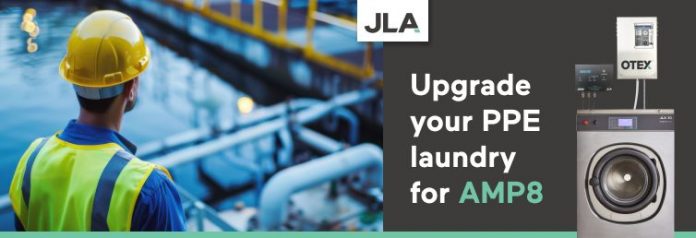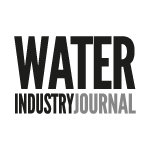Nick Wojtowycz, utilities specialist at JLA, explains why switching to ozone disinfection laundry technology can help prolong PPE life, better protect workers, and help wastewater operators achieve significant energy savings in line with AMP8 goals.
As the industry settles into the AMP8 cycle, we continue to hear from utilities firms seeking new ways to balance workforce safety and operational compliance with the need to meet ambitious carbon reduction targets, all without compromising the efficient running of their infrastructure.
It’s an environment in which investment decisions are more important – and more difficult – than ever. But AMP8 has also given sector leaders an opportunity to explore alternatives to status-quo systems and processes in search of longer-term sustainability, not to mention savings.
The challenges of thermal disinfection for PPE
One area of focus under AMP8 is safety-critical equipment, which for many firms will include industrial laundry systems whose features should also help to realise time, energy and cost savings.
In wastewater environments, of course, PPE including overalls, gloves and masks, give workers essential protection against sludge, pathogens and odours. But cleaning and fully disinfecting this PPE in time for the next shift can be an intensive process, heavy on resources, and often hard to verify from a compliance standpoint.
These challenges are only compounded by day-to-day practicalities: workwear care labels will often specify 40C washing only, which is often too low to achieve effective disinfection. Higher-heat washes of 60C, meanwhile, are known to damage protective fibres, hampering PPE performance, shortening its life, while potentially leaving behind harmful residues which can expose staff to cross-contamination.
This is one reason that JLA’s OTEX ozone disinfection system presents a safer, more sustainable solution – and why more wastewater operators are turning to the technology to manage their daily cleaning.
OTEX: a natural alternative to thermal disinfection
Originally developed for the healthcare sector, OTEX uses the natural cleaning power of ozone gas instead of heat to destroy 99.999% of harmful microbes – including MRSA, E. coli and norovirus – even at low wash temperatures.
This feature alone means operators can achieve hospital-grade disinfection while looking after the delicate protective fibres that thermal washes can often damage. In turn, OTEX can protect teams, make costly PPE last longer, and bring operating costs down – all desirable outcomes in a period where both sustainability and safety are non-negotiables.
Beyond performance, the OTEX system also provides disinfection validation, helping to improve standards of accountability. Each wash cycle can generate a receipt showing that full PPE disinfection has been achieved. This way, operators are able to keep an audit-friendly paper trail that satisfies relevant environmental health, water safety and welfare standards. And as extra assurance, WRc assessment has shown that the OTEX wash process has no harmful impact on wastewater discharge.
Improving efficiency and carbon savings
While traditional hot-wash systems tend to use large volumes of electricity and water, OTEX ozone technology uses up to 35% less energy and water per cycle. In practical terms, this allows operators to save money and demonstrate real progress towards AMP8’s emissions goals.
But when viewed through the lens of total cost of ownership, the advantages of OTEX investment become even clearer. A longer PPE lifespan, reduced detergent use and lower maintenance requirements can all contribute to operational savings that are likely to add up, year on year. And thanks to all-inclusive equipment and support packages like Total Care, which have no upfront capital outlay, there’s one less barrier in procurement.
What’s more, the latest generation of remote monitoring technology helps teams enjoy complete visibility of their usage, estimated costs and carbon output across their site, allowing them to spot inefficiencies early and make informed decisions. It’s another way to better manage resources, find potential savings, and demonstrate real performance in line with AMP8’s long-term sustainability objectives.




